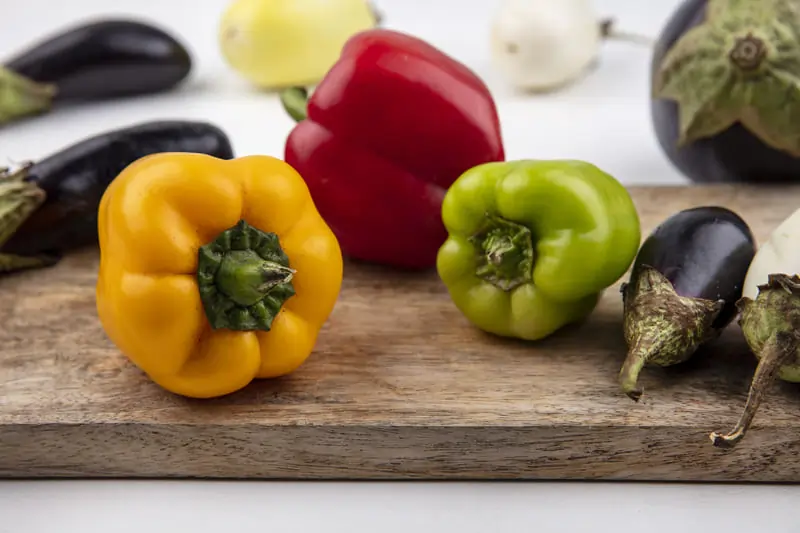What color bell pepper is the healthiest have been a common question asked. Bell peppers are not only vibrant and delicious but also packed with essential nutrients that benefit your health. Their variety of colors—green, red, yellow, and orange—provides a unique nutritional profile for each type. But which color is the healthiest? The answer depends on your health goals and the nutrients you’re looking for.
To maximize your health benefits, it’s essential to understand the phytonutrients in these colorful vegetables. Learn more about the role of peppers, in overall health by checking out this guide to the benefits of eating peppers.
Nutritional Value of Bell Peppers: What Color Bell Pepper Is the Healthiest?
Bell peppers are a nutritional powerhouse, offering an impressive array of health benefits in a low-calorie package. Available in vibrant colors such as green, red, yellow, and orange, these versatile vegetables are an essential addition to any balanced diet.
Low in Calories but Nutrient-Dense
- Calorie Count: With only about 30 calories per 100 grams, bell peppers are an excellent choice for weight-conscious individuals. Their high water content and low calorie density make them filling without contributing to weight gain.
- Perfect for Healthy Recipes: They are ideal for snacks, salads, or as a base for dishes like stuffed bell peppers. For a flavorful way to enjoy these peppers, try Old-Fashioned Stuffed Bell Peppers, which highlights their versatility.
Rich in Vitamin C
- Boosting Immunity: Bell peppers are one of the richest sources of Vitamin C, with red and orange peppers containing significantly higher levels than their green counterparts. A 100-gram serving of red bell peppers provides more than 150% of the recommended daily intake of Vitamin C, supporting immune function and skin health.
- Cooking Tips: While raw peppers retain the most Vitamin C, lightly roasting or stir-frying them can bring out their natural sweetness without depleting their nutrient content.
Good Source of Fiber
- Digestive Benefits: With about 2 grams of fiber per serving, bell peppers contribute to healthy digestion and promote gut health. Fiber also helps regulate blood sugar levels, making bell peppers a great option for individuals with diabetes.
- Pairing Ideas: Pair bell peppers with other high-fiber vegetables like eggplant or zucchini for a nutritious side dish. For more insights on preparation, visit Should You Peel Eggplant for Eggplant Parmesan?, which offers tips for maximizing the nutritional value of vegetables.
Packed with Antioxidants
- Beta-Carotene and Lutein: Bell peppers are rich in antioxidants such as beta-carotene. It supports vision and skin health, and lutein, which is essential for eye health. These compounds also help protect cells from oxidative stress, reducing the risk of chronic diseases like heart disease and cancer.
- Red vs. Green Peppers: Red bell peppers contain higher levels of beta-carotene compared to green ones. It makes them a more potent option for boosting antioxidant intake. You may explore Rare and Unique Pepper Varieties, which showcases different types and their benefits.
Nutritional Value of Bell Peppers: What Color Bell Pepper Is the Healthiest?

Green bell peppers, though often less sweet than their red, yellow, or orange counterparts, offer a wealth of health benefits. Their distinct flavor and nutrient profile make them a valuable addition to a variety of dishes, from stir-fries to stuffed bell peppers.
Flavor Profile and Nutritional Highlights
- Slightly Bitter Taste: Green bell peppers are harvested before fully ripening, which gives them their signature crisp texture and mild bitterness. While some prefer sweeter peppers, green bell peppers pair exceptionally well with robust flavors like garlic and onion.
- Rich in Chlorophyll: As the green pigment in plants, chlorophyll is a powerful antioxidant that supports cellular detoxification and overall health.
- Lutein and Zeaxanthin: These carotenoids are especially beneficial for eye health, helping to protect against age-related macular degeneration (AMD) and other vision-related issues. Green peppers contain higher levels of these compounds compared to their more ripened counterparts.
For a recipe that highlights their versatility, try incorporating green bell peppers into Old-Fashioned Stuffed Bell Peppers, which balances their bitterness with flavorful fillings.
Health Benefits Of Bell Pepper.
- Promotes Healthy Vision:
- The lutein and zeaxanthin in green bell peppers act as natural filters for blue light, reducing strain on the eyes and protecting retinal cells. This makes them an excellent choice for maintaining good vision, especially as part of a diet rich in antioxidants.
- Cellular Detoxification:
- Chlorophyll in green bell peppers helps the body detoxify by neutralizing free radicals and supporting liver health. It aids in eliminating harmful toxins and reducing inflammation, which contributes to overall well-being.
- Immune Support:
- While not as rich in Vitamin C as red bell peppers, green bell peppers still provide a significant amount of this nutrient, which boosts immune function and supports skin health.
Incorporating Green Bell Peppers into Your Diet
- As a Base for Stuffed Dishes: Their sturdy structure and slightly bitter flavor make green bell peppers ideal for stuffing. Pair them with grains, beans, or proteins for a hearty meal. For tips on preparing stuffed vegetables, Explore the Substitute for Eggs in Breading Eggplant?.
- In Stir-Fries or Curries: Sauté green bell peppers with spices and other vegetables for a quick and nutritious side dish.
- Raw in Salads: Add sliced green bell peppers to salads for a crisp, refreshing crunch that complements leafy greens and tangy dressings.
Green bell peppers are a versatile and nutritious choice, offering unique benefits that contribute to a balanced diet. Whether you’re looking to boost your eye health, detoxify your body, or simply enjoy their bold flavor, these peppers are a must-have in your kitchen. For more ideas on incorporating peppers into your meals, visit Rare and Unique Pepper Varieties to explore their potential in different recipes.
Health Benefits by Color: Red Bell Peppers
Red bell peppers are the sweetest and most nutrient-rich of all bell pepper varieties. Their vibrant color and high levels of antioxidants make them a favorite for both flavor and health benefits, contributing significantly to a balanced diet.
Flavor Profile and Nutritional Highlights
- Naturally Sweet: Unlike their green counterparts, red bell peppers are fully ripened, which gives them their sweet, mellow taste. This makes them ideal for raw preparations like salads or roasted dishes.
- Rich in Vitamin C: A single serving of red bell peppers provides over 200% of the recommended daily intake of Vitamin C, making them a powerhouse for immune support and skin health.
- Beta-Carotene and Lycopene: These antioxidants contribute to the pepper’s vibrant red hue and offer protection against cellular damage. Beta-carotene supports vision and immune function, while lycopene is known for its role in reducing cancer risks.
Health Benefits
- Boosts Immune System:
- The exceptionally high Vitamin C content in red bell peppers strengthens the immune system, helping the body fight off colds, infections, and other illnesses. This nutrient also enhances iron absorption, making it an essential component of a healthy diet.
- Promotes Healthy Skin:
- Vitamin C is critical for collagen production, which maintains skin elasticity and prevents premature aging. Regular consumption of red bell peppers can lead to healthier, more vibrant skin.
- Protects Against Certain Cancers:
- Lycopene, a powerful antioxidant found in red bell peppers, has been shown to reduce the risk of several types of cancer, including prostate and lung cancer. Its ability to combat oxidative stress makes it a valuable addition to a diet focused on disease prevention.
Incorporating Red Bell Peppers into Your Diet
- Roasted and Grilled: Roasting red bell peppers enhances their natural sweetness, making them a perfect addition to pasta dishes, sandwiches, or as a topping for pizza. For more vegetable preparation tips, visit Should You Peel Eggplant for Eggplant Parmesan?.
- In Soups and Sauces: Blend roasted red bell peppers into creamy soups or purée them for a rich, flavorful pasta sauce.
- Raw in Salads: Add sliced red bell peppers to salads for a pop of color and natural sweetness. Their crisp texture pairs beautifully with leafy greens and vinaigrettes.
Red bell peppers are a delicious and nutrient-packed addition to any meal. Their high levels of Vitamin C, beta-carotene, and lycopene make them a standout choice for those looking to support their immune system, enhance skin health, and protect against chronic diseases. For additional ideas on incorporating peppers into your meals, explore Rare and Unique Pepper Varieties to discover how different types can elevate your cooking.
Health Benefits by Color: Yellow and Orange Bell Peppers
Yellow and orange bell peppers bring a vibrant touch to dishes with their mild sweetness and tangy flavor. These varieties are not only visually appealing but also packed with essential nutrients that provide a wide range of health benefits.
Flavor Profile and Nutritional Highlights
- Mild and Sweet: Yellow and orange bell peppers are slightly less sweet than red peppers but have a tangier taste, making them versatile for raw and cooked dishes. Their bright colors add visual appeal to salads, stir-fries, and stuffed recipes.
- Rich in Vitamin A: These peppers are an excellent source of Vitamin A, which is crucial for maintaining healthy vision, supporting the immune system, and promoting cell growth.
- Beta-Carotene: The bright hues of yellow and orange peppers come from beta-carotene, an antioxidant that the body converts into Vitamin A. Beta-carotene also contributes to healthy skin and protects against cellular damage.
For inspiration on using these peppers, consider recipes like Old-Fashioned Stuffed Bell Peppers, where their natural sweetness balances the savory fillings.
Health Benefits
- Supports Lung Health and Reduces Inflammation:
- Beta-carotene in yellow and orange peppers has anti-inflammatory properties, which can help protect the lungs from damage caused by pollutants and toxins. This makes them an excellent choice for individuals with respiratory conditions or those seeking to reduce inflammation.
- Enhances Vision and Protects Against Night Blindness:
- Vitamin A plays a vital role in maintaining good vision, particularly in low-light conditions. Regular consumption of yellow and orange peppers helps prevent night blindness and supports overall eye health. Lutein and zeaxanthin, additional carotenoids found in these peppers, protect the retina from oxidative damage.
- Immune Support:
- Like their red counterparts, yellow and orange peppers contribute to a strong immune system by providing Vitamin C and antioxidants that help the body fight off infections and illnesses.
Incorporating Yellow and Orange Bell Peppers into Your Diet
- Raw in Snacks or Salads: These peppers’ crisp texture and mild flavor make them ideal for snacking or adding to salads. Pair them with hummus or guacamole for a nutritious snack.
- Grilled or Roasted: Enhance their natural sweetness by grilling or roasting them alongside other vegetables. This preparation method caramelizes their sugars, intensifying their flavor. For more tips on preparing roasted vegetables, visit Should You Peel Eggplant for Eggplant Parmesan?.
- Stuffed Peppers: Use yellow or orange peppers as a base for stuffed recipes, filling them with grains, beans, or proteins for a vibrant main course.
- Blended in Soups or Sauces: Add roasted yellow or orange peppers to soups or sauces to create a creamy, flavorful dish that’s rich in nutrients.
Yellow and orange bell peppers are not just a treat for the eyes but also a valuable addition to a healthy diet. Their rich Vitamin A and beta-carotene content provide essential benefits for vision, lung health, and immune support. For further inspiration on how to incorporate peppers into your meals, explore Rare and Unique Pepper Varieties to expand your culinary creativity.
Comparing Nutrients: Green, Red, Yellow, and Orange Bell Peppers

| Color | Key Nutrients | Primary Health Benefit |
|---|---|---|
| Green | Lutein, chlorophyll | Eye health, detoxification |
| Red | Vitamin C, lycopene | Immunity, skin health |
| Yellow/Orange | Beta-carotene, Vitamin A | Vision, lung health |
Including a variety of colors in your diet ensures you reap the diverse benefits of bell peppers.
Culinary Uses and Practical Advice
How to Use Bell Peppers in Cooking
Bell peppers are versatile and can be enjoyed raw or cooked:
- Add sliced red peppers to salads for a sweet crunch.
- Roast yellow peppers for soups or pasta dishes.
- Dice green peppers into stir-fries or tacos for a bitter edge.
If you enjoy experimenting in the kitchen, you might also find this banana bread cookies recipe helpful for creative snack ideas.
How to Maximize Nutrient Retention
- Avoid Overcooking: Excessive heat can destroy Vitamin C.
- Roasting: Enhances the natural sweetness of peppers while preserving nutrients.
- Storage: Keep bell peppers in the refrigerator to maintain freshness and vitamin content.
FAQs What Color Bell Pepper Is the Healthiest?
What is the healthiest color bell pepper?
The healthiest color depends on your needs. Red peppers are richest in Vitamin C, while green peppers excel in antioxidants like lutein. Learn more about balancing your diet with this guide to versatile recipes.
Are all bell peppers good for you?
Yes, all bell peppers are low in calories and rich in vitamins, making them a healthy addition to your diet.
Do different colors taste different?
Yes. Green peppers are slightly bitter, red peppers are sweet, and yellow/orange peppers have a mild tangy sweetness.
Can bell peppers help with weight loss?
Absolutely. Bell peppers are low in calories, high in fiber, and can be a satisfying snack or meal addition.
What’s the best way to store bell peppers?
Store them in the refrigerator in a plastic bag or crisper drawer to maintain freshness for up to a week.
Conclusion
So, what color bell pepper is the healthiest? The answer depends on your nutritional priorities. Red bell peppers are a Vitamin C powerhouse, green peppers excel in chlorophyll and lutein, and yellow/orange peppers shine with beta-carotene. By incorporating a variety of colors into your diet, you’ll enjoy a full spectrum of health benefits while adding vibrant flavors to your meals.

